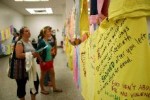
More than 200 brightly- colored T-shirts decorated the Tech Pride Room Tuesday.Tech’s Women’s Center has been hanging shirts for more than 13 years now, all representing one cause: to break the silence.
“The Clothesline Project was a way to break the silence on domestic violence against women,” said Gretta Stanger, sociology associate professor and Women’s Center director. “Each shirt is one person’s account of what has happened to them.”
The Clothesline Project is a visual display that bears witness to violence against women. During the display, a clothesline is hung with shirts. Each shirt is decorated by the survivor herself or by someone who cares about her to represent a particular woman’s experience.
The project started with 31 shirts hung in Hyannis, Mass. in the fall of 1990. Since that time, projects have begun in communities all across the country.
“The Women’s Center started the displays in 1998,” said Stanger, “and we try to have them up in the community at least once a year.”
The purpose of the project is to bear witness to the survivors as well as the victims of the war against women; to help with the healing process for the people who have lost a loved one or are survivors of this violence; to educate and raise society’s awareness of the extent of the problem of violence against women; and to provide a nationwide network of support, encouragement and information for the other communities starting their own Clothesline Projects.
“Not only Tech students,” Stanger said, “but staff and support groups have also added to the collection as well. April is the month we usually have our display, due to the fact that it’s child abuse and sexual abuse awareness month.”
Shirts, blouses or T-shirts of durable material are suggested and should follow a color code. White represents women who have died because of violence. Yellow and beige represent battered or assaulted women. Red, pink and orange are for survivors of rape and sexual assault. Blue and green are for survivors of incest and sexual abuse. Purple represents women attacked because of their sexual orientation.
To participate, shirts may be made in the Women’s Center during office hours. Shirts may be brought to a display of the Clothesline or mailed to the Clothesline Project.
“Students can be a big part of the Clothesline Project,” Stanger said, “by just volunteering to tie the ropes and hang the shirts or just share with friends and other organizations about this project.”
According to the National Center for Victims of Crime, one out of two women will be in a violent relationship, and Survivors of Incest Anonymous reports that one out of three girls and one out of five boys will be victims of incest or sexual assault before the ages of 18.


